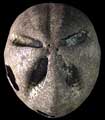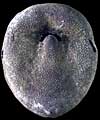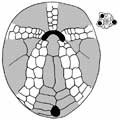The Echinoid Directory
Amphipneustes Koehler, 1900, p. 817
[=Antipneustes Koehler, 1926, p. 69 (nom. van.); = Pseudabatus Koehler, 1911, p. 60, type species P. nimrodi Koehler, 1911; ?=Parapneustes Koehler, 1912, p. 161, type species Parapneustes cordatus, Koehler, 1912 ]
| Diagnostic Features |
|
|---|---|
| Distribution | Recent, circum-Antarctic and subantarctic waters. |
| Name gender | feminine |
| Type | Amphipneustes lorioli Koehler, 1901, p. 12, by original designation. |
| Species Included |
|
| Classification and/or Status |
|
| Remarks |
|
| Contributor comments: | Some species of Amphipneustes have developed a lateral fasciole in early ontogenetic stage. In A. rostratus it is present up to a test length of about 25 mm, in A. marsupialis it occurs at least in long-spined juveniles. In adult specimens it is lost . [Heinke Schultz, August 2007] |




